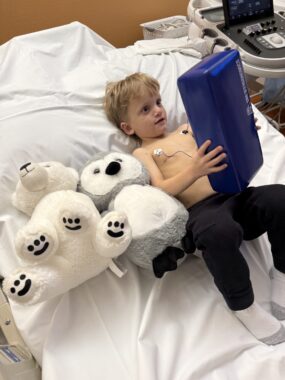Keeping that cloud of uncertainty at bay for yet another day
My son with Alagille syndrome is doing well, but I'm always a bit on edge

Alagille syndrome is such an interesting condition in that it affects every individual differently. With my 4-year-old son, Finley, who has the syndrome, much of our focus has been on our gastroenterology appointments, making sure he gets sufficient nutrition, and monitoring his status. Finley has been stable and doing well for some time, so it can be easy to overlook the other components of his condition that aren’t always front and center — at least until the next doctor’s appointment, that is.
The most recent example of this was a cardiology appointment. When Finley was an infant and going through the diagnosis phase, doctors discovered a heart murmur. An echocardiogram revealed that he has pulmonary valve stenosis, meaning that one of his heart arteries is narrowed. That was another scary diagnosis added to our plate as we navigated helping a child who had been labeled as “failure to thrive.”
Cautious optimism
Thankfully, the artery narrowing was mild, so there was no need for immediate intervention. And that trend has continued as Finley has grown. At each cardiology appointment, doctors have said that the artery continues to grow along with Finley, and it’s approaching the range of being normal. We’ll continue to monitor his heart, but the fear we once had about it has dissipated substantially.

Some of Finley’s furry friends accompanied him to his recent cardiology appointment, where he had an echocardiogram. (Photo by Jay Sandstrom)
That’s not to say we don’t still worry. Raising a child with a rare disease is like having a black cloud always looming in the distance. While it’s there, it doesn’t mean it’ll automatically rain and ruin our day, but it might. I never know if the next doctor’s appointment will uncover something new that’ll change our entire way of raising Finley.
As Finley and I recently headed to the hospital for his annual cardiology appointment, which included having an echocardiogram early in the morning, those anxious feelings crept in again. In my head, I know his heart condition has been stable, and we just need to monitor it. But I’ll wonder if anything has changed in the past year, and if something unexpected awaits us.
I’ve written previously about how stressful it is to sit there and watch Finley get an echocardiogram or an ultrasound. I look at the images on the screen, and I have no idea what they mean. That metaphorical cloud looms large during those moments, and I find myself asking questions like, “Why did they pause on that image?” “Why is that something they’re measuring?” I’ve sat through more of those appointments than I’d like to, and the feeling is always the same: cautious optimism with a tinge of worry.
Thankfully, the recent cardiology appointment revealed no new information. Finley’s heart is doing well, and the narrowed artery continues to grow. We can now have the cardiology appointments every two years instead of annually, which is a breath of fresh air. I consider reducing the frequency of even one appointment a win.
Finley did great. He sat still during the echocardiogram, he was silly with the nurses, and he brought great energy to the room. I was glad that I could drive him to school afterward with that black cloud pushed off a little farther into the distance. And I’m hopeful that we can keep it there for a long time to come.
Note: Liver Disease News is strictly a news and information website about the disease. It does not provide medical advice, diagnosis, or treatment. This content is not intended to be a substitute for professional medical advice, diagnosis, or treatment. Always seek the advice of your physician or other qualified health provider with any questions you may have regarding a medical condition. Never disregard professional medical advice or delay in seeking it because of something you have read on this website. The opinions expressed in this column are not those of Liver Disease News or its parent company, Bionews, and are intended to spark discussion about issues pertaining to liver disease.







Leave a comment
Fill in the required fields to post. Your email address will not be published.